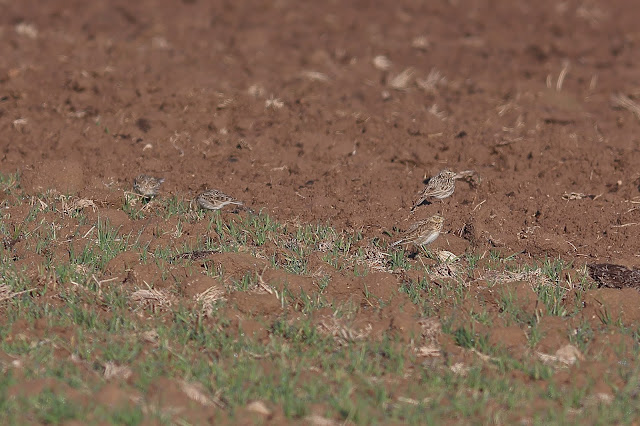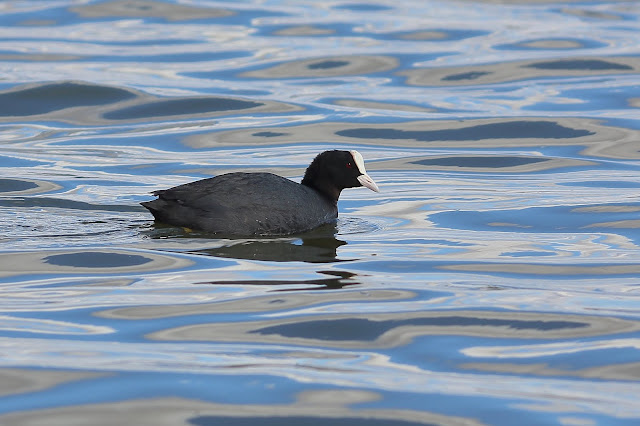Hola una vez más.
Hi again.
En el siguiente enlace podéis ver nuestros próximos viajes fotográficos y de observación de aves y mamíferos nacionales y al extranjero. Espero que os gusten y os animéis a venir conmigo. Una experiencia que nunca olvidareis. Estos viajes están condicionados a la situación en que se encuentren los destinos con respecto a la pandemia del coronavirus.
In the following link you can see our next national and foreign Birds and Mammals photographic and observation trips. I hope you like them and I encourage you to come with me. An experience that you will not forget. These trips are conditioned to the situation in which the destinations are with respect to the coronavirus pandemic.
Esta semana os muestro algunas aves que pude fotografiar en La Mancha Húmeda.
This week I show you some birds that I was able to photograph in La Mancha Húmeda.
Primero quise observar algunas aves esteparias de camino a las lagunas. No pude detenerme mucho pero no se dio mal del todo.
First I wanted to observe some steppe birds on the way to the lagoons. I couldn't stop for long but it wasn't bad.
El día fue bueno aunque a ratos las nubes tapaban el sol y hacia un poco más de viento del deseado.
The day was good although at times clouds covered the sun and it was a little more windy than desired.
Lo primero que vi fueron bastantes alondras comunes (Alauda
arvensis).
First thing I saw were quite a few Eurasian Skylark.
En la zona visitada había al menos dos parejas de alcaravanes comunes (Burhinus
oedicnemus). Que difíciles son de ver y que lejos suelen estar de los caminos.
In the area visited there were at least two pairs of Stone Curlews. How difficult they are to spot and how far they are usually from trails.
Solo vi esta pareja de ganga ortega (Pterocles
orientalis). La hembra es la que va primero.
I only saw this pair of Black-bellied
Sandgrouse. Female goes first.
Unos se vienen y otros se van. Este es el caso de las grullas comunes que pude observar saliendo de sus lugares de descanso durante la migración. Ya no os volveremos a ver por nuestro territorio hasta octubre. Espero que leguéis bien a vuestro destino estival y que consigáis sacar adelante a muchos pollos.
Some come and others go. This is the case of the Common Cranes that I was able to observe leaving their resting places during the migration. We will not see you again in our territory until October. I hope you get on well to your summer destination and that you manage to raise many chicks.
Avutardas comunes (Otis
tarda).
Great Bustards.
Este bando era más numeroso.
This flock was bigger.
Solo pude ver en todo el día cinco perdices rojas (Alectoris
rufa). Recuerdo que hace años que en una mañana se veían muchas. Es una pena el declive que esta especie está sufriendo en nuestros campos.
I could only see five Red-legged
Partridge in all day. I remember years ago that in a morning many could be observed. It is a pity the decline that this species is suffering in our fields.
Ya en las lagunas la cosa se dio muy bien. En la foto una lavandera boyera (Motacilla
flava).
Already at the lagoons things turned out very well. In the photo a Yellow
Wagtail.
Ánsar común (Anser
anser).
Greylag
Goose.
Había muchos más zampullines cuellinegros (Podiceps
nigricollis) que en la última visita que hice el año pasado por diciembre. Este aun conservaba algo del plumaje de invierno.
There were many more Black-necked Grebes than in the last visit I made last year in December. This one still had some of its winter plumage.
Pero la mayoría ya lucían sus mejores galas.
But most were already wearing their best clothes.
Aun se podían observar escribanos palustres (Emberiza
schoeniclus). En la foto un macho.
Common Reed
Bunting could still be seen. In the photo a male.
Hembra.
Female.
Ya se podían ver algunas golondrinas comunes (Hirundo
rustica).
Some Barn
Swallow could already be seen.
También había muchas malvasías cabeciblancas (Oxyura
leucocephala). Los machos ya están bonitos con su plumaje nupcial.
There were also many White-headed
Duck. Males are already pretty in their breeding plumage.
Hembra.
Female.
Como es habitual, había bastantes flamencos comunes (Phoenicopterus
ruber). En la foto un ejemplar de primer año.
As usual, there were quite a few Greater
Flamingo. In the photo a first year specimen.
Segundo año.
Second yerar.
Adulto.
Adult.
En este vídeo podéis apreciar que los adultos ya estaban iniciando el cortejo.
In this video you can see that the adults were already starting the courtship.
Había muchas gaviotas sombrías (Larus fuscus).
There were many Lesser
Black-backed Gulls.
Al igual que gaviotas reidoras (Chroicocephalus
ridibundus).
As well as Black-headed
Gulls.
Al menos tres parejas de aguiluchos laguneros occidentales (Circus
aeruginosus) andaban por la laguna. Este era uno de los machos.
At least three pairs of Eurasian Marsh
Harrier were at the Lagoon. This was one of the males.
Y esta una de las hembras.
And this is one of the females.
Focha común (Fulica
atra).
Common
Coot.
Este bonito ejemplar de pato colorado (Netta
rufina) tuvo a bien pasarse por delante del observatorio donde estaba en ese momento.
This beautiful specimen of Red-crested Pochard saw fit to walk past the observatory where I was at that time.
Precioso.
Beautiful.
Había muchos mosquiteros comunes (Phylloscopus
collybita).
There were plenty Common
Chiffchaff.
Zampullín común (Tachybaptus
ruficollis). Este ejemplar conservaba aun el plumaje de invierno.
Little Grebe. This specimen still retained its winter plumage.
Mientras que este otro ya estaba con su plumaje nupcial.
While this other was already in its breeding plumage.
Agujas colinegras (Limosa
limosa). Fue una pena que ninguna quisiese ponerse cerca pues algunas ya estaban muy bonitas.
Black-tailed
Godwit. It was a shame that none of them wanted to get close as some were already very pretty.
Un macho de tarabilla europea (Saxicola rubicola). Su hembra no quiso posar para la cámara.
A male Common
Stonechat. Its female did not want to pose for my camera.
Bisbita alpino (Anthus
spinoletta).
Water
Pipit.
Vi varios calamones comunes (Porphyrio
porphyrio) pero todos muy lejos.
I saw several Purple Swamphen but all very far away.
Había varias parejas de tarros blancos (Tadorna
tadorna). En la foto una de ellas.
There were several pairs of Common Shelduck. In the photo one of them.
Dos machos de ánade azulón (Anas
platyrhynchos).
Two males of Mallard.
De todas las aves que vi y fotografié, ese fue la que más ilusión me hizo. Se trata de un archibebe oscuro (Tringa
erythropus) que no lo tenía yo fotografiado desde tan cerca. Es una pena que no estuviese en plumaje nupcial que es cuando están realmente bonitos. En este caso se trataba de un ejemplar en paso migratorio pre nupcial hacia el norte de Europa que es en donde se reproducen.
Of all Birds I saw and photographed, this was the one that made me most excited. It is a Spotted
Redshank that I had not photographed from so close. It is a pity that it was not in breeding plumage which is when they are really beautiful. In this case it was a specimen in a pre-nuptial migration to northern Europe, where they reproduce.
Lavandera blanca (Motacilla
alba).
White
Wagtail.
Macho de porrón europeo (Aythya
ferina).
Common
Pochard male.
Aunque había muchas cuchara comunes (Spatula
clypeata) ninguna se puso cerca.
Although there were many Northern
Shoveler none came close.
Menos abundantes eran las cercetas comunes (Anas
crecca) que podéis ver en el fondo de la imagen. Tampoco las pude sacar fotos cercanas.
Less abundant were the Common Teals that you can see in the background of the photo. Also this time I could not take close photos.
Un macho de cigüeñuela común (Himantopus
himantopus).
A male Black-winged
Stilt.
Por la tarde, después de los colegios, la gente se acerca a la laguna con sus hijos y no respetan al observador de aves pues hacen mucho ruido y juegan alrededor de los observatorios lo que conlleva que las aves se distancien mucho. Es una pena. Por ello, antes de lo deseado, me fui de la laguna y pasé a ver si ya habían llegado los cernícalos primilla. Allí estaban ya. En la foto un macho.
In the afternoon, after school, people go to the lagoon with their children and they do not respect the bird watcher as they make a lot of noise and play around the observatories, which means that Birds become very distant. It's a shame. Therefore, earlier than desired, I left the lagoon and went to see if the Lesser Kestrels had already arrived. There they were already. In the photo a male.
Hembra.
Female.
Ya más cerca de Madrid, observé un águila posada que aunque estaba bastante lejos me pareció que era muy grande. Pude hacer una parada no muy lejos de donde la había visto y comprobé que se trataba de un águila imperial ibérica (Aquila adalberti).
Closer to Madrid, I observed a perched eagle that, although it was quite far away, seemed to me to be very large. I was able to make a stop not far from where I had seen it and found that it was a Spanish Imperial Eagle.
Si queréis suscribiros a este blog de los viajes que hacemos pincha en el siguiente enlace: Suscribirse y haz clic en ¿ Quieres suscribirte a nuestro blog?
If you want to subscribe to this post about the trips we do, click on the following link: Susbcribe and click on: Do you want to subscribe to our blog?
Espero que os haya gustado y hasta pronto.
I hope you like it and see you soon.
































































No hay comentarios:
Publicar un comentario